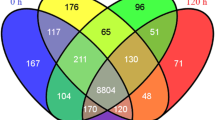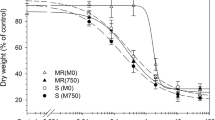Abstract
Objectives
The tolerance to organophosphate pesticide, dichlorvos, is essential for the application of Trichoderma in bioremediation and integrated pest management, although the molecular events associated with the tolerance process have not yet been elucidated.
Results
RNA-seq analysis of wild-type Trichoderma atroviride T23 and the hex1-deleted mutant under dichlorvos stress was designed to search for genes involved in the tolerance process. A total of 5382 differentially expressed genes were identified, highlighting the complex transcriptional changes of T. atroviride in response to dichlorvos stress. 137 genes were regulated by dichlorvos and hex1, encoding major facilitator superfamilies, cytochrome P450, glutathione-S-transferase, flavoprotein, Hsp70, Hsp90, etc. Pathway and expression analysis indicated that ABC transporters were affected by the disruption of hex1 gene and might play a vital role in the tolerance process. Expression patterns of seven selected ABC transporter genes were confirmed by qRT-PCR after exposure to dichlorvos for 2, 6 and 24 h.
Conclusions
The present study provides insights into the genetic basis of dichlorvos tolerance in Trichoderma that may be exploited for further development of bioremediation or biocontrol agents.




Similar content being viewed by others
References
Ammar GA, Tryono R, Döll K, Karlovsky P, Deising HB, Wirsel SGR (2013) Identification of ABC transporter genes of Fusarium graminearum with roles in azole tolerance and/or virulence. PLoS One 8:e79042
Anders S, Huber W (2010) Differential expression analysis for sequence count data. Genome Biol 11:R106
Cannon RD, Lamping E, Holmes AR et al (2009) Efflux-mediated antifungal drug resistance. Clin Microbiol Rev 22:291–321
Conesa A, Götz S, García-Gómez JM, Terol J, Talón M, Robles M (2005) Blast2GO: a universal tool for annotation, visualization and analysis in functional genomics research. Bioinformatics 21:3674–3676
Contreras-Cornejo HA, Macías-Rodríguez L, Cortés-Penagos C, López-Bucio J (2009) Trichoderma virens, a plant beneficial fungus, enhances biomass production and promotes lateral root growth through an auxin-dependent mechanism in Arabidopsis. Plant Physiol 149:1579–1592
Dubey MK, Jensen DF, Karlsson M (2014) An ATP-binding cassette pleiotropic drug transporter protein is required for xenobiotic tolerance and antagonism in the fungal biocontrol agent Clonostachys rosea. Mol Plant Microbe Interact 27:725–732
Ernst R, Kueppers P, Stindt J, Kuchler K, Schmitt L (2010) Multidrug efflux pumps: substrate selection in ATP-binding cassette multidrug efflux pumps–first come, first served? FEBS J 277:540–549
Gao J, Liu L, Liu X, Zhou H, Lu J, Huang S, Wang Z (2009) The occurrence and spatial distribution of organophosphorous pesticides in Chinese surface water. Bull Environ Contam Toxicol 82:223–229
Grigoriev IV, Nordberg H, Shabalov I et al (2011) The genome portal of the Department of Energy Joint Genome Institute. Nucl Acids Res 40:D26–D32
Harman GE, Howell CR, Viterbo A, Chet I, Lorito M (2004) Trichoderma species—opportunistic, avirulent plant symbionts. Nat Rev Microbiol 2:43–56
Jedd G, Chua NH (2000) A new self-assembled peroxisomal vesicle required for efficient resealing of the plasma membrane. Nat Cell Biol 2:226–231
Kanehisa M, Goto S, Sato Y, Furumichi M, Tanabe M (2012) KEGG for integration and interpretation of large-scale molecular data sets. Nucl Acids Res 40:D109–D114
Kazemi M, Tahmasbi A, Valizadeh R, Naserian A, Soni A (2012) Organophosphate pesticides: a general review. Agric Sci Res J 2:512–522
Kovalchuk A, Driessen AJM (2010) Phylogenetic analysis of fungal ABC transporters. BMC Genomics 11:177
Li R, Yu C, Li Y, Lam TW, Yiu SM, Kristiansen K, Wang J (2009) SOAP2: an improved ultrafast tool for short read alignment. Bioinformatics 25:1966–1967
Morschhäuser J (2010) Regulation of multidrug resistance in pathogenic fungi. Fungal Genet Biol 47:94–106
Mortazavi A, Williams BA, McCue K, Schaeffer L, Wold B (2008) Mapping and quantifying mammalian transcriptomes by RNA-Seq. Nat Methods 5:621–628
Nornberg BF, Batista CR, Almeida DV, Trindade GS, Marins LF (2015) ABCB1 and ABCC4 efflux transporters are involved in methyl parathion detoxification in ZFL cells. Toxicol In Vitro 29:204–210
Paul S, Moye-Rowley WS (2014) Multidrug resistance in fungi: regulation of transporter-encoding gene expression. Front Physiol 5:143
Ren Z, Zhang X, Wang X et al (2014) AChE inhibition: one dominant factor for swimming behavior changes of Daphnia magna under DDVP exposure. Chemosphere 120:252–257
Sanglard D, Coste A, Ferrari S (2009) Antifungal drug resistance mechanisms in fungal pathogens from the perspective of transcriptional gene regulation. FEMS Yeast Res 9:1029–1050
Sun W, Chen Y, Liu L, Tang J, Chen J, Liu P (2010) Conidia immobilization of T-DNA inserted Trichoderma atroviride mutant AMT-28 with dichlorvos degradation ability and exploration of biodegradation mechanism. Bioresour Technol 101:9197–9203
Tang J, Liu L, Hu S, Chen Y, Chen J (2009) Improved degradation of organophosphate dichlorvos by Trichoderma atroviride transformants generated by restriction enzyme-mediated integration (REMI). Bioresour Technol 100:480–483
Tang J, Liu L, Huang X, Li Y, Chen Y, Chen J (2010) Proteomic analysis of Trichoderma atroviride mycelia stressed by organophosphate pesticide dichlorvos. Can J Microbiol 56:121–127
Tang J, Li Y, Fu K et al (2014) Disruption of hex1 in Trichoderma atroviride leads to loss of Woronin body and decreased tolerance to dichlorvos. Biotechnol Lett 36:751–759
Tripathi P, Singh PC, Mishra A, Chauhan PS, Dwivedi S, Bais RT, Tripathi RD (2013) Trichoderma: a potential bioremediator for environmental clean up. Clean Technol Environ Policy 15:541–550
Acknowledgments
This work was supported by Grants from the National Natural Science Foundation of China (31270155, 31440025, 31201557), Natural Science Foundation of Shanghai (12ZR1414100), Key Basic Research Project of Shanghai Municipal Science and Technology Commission (12JC1404600), Special Project of Basic Work Project for Science and Technology (2014FY120900). The authors thank Zhe Zhang for Perl programming, and Weixuan Wu for the help in qPCR data analysis.
Conflict of interest
The authors declare that they have no conflict of interest.
Supporting information
Supplementary Table 1—Genes and PCR primers used for quantitative PCR analysis.
Supplementary Table 2—137 candidate genes involved in dichlorvos tolerance and regulated by hex1 from cluster I and III. 25 genes involved in transport activity are highlighted.
Supplementary Table 3—28 ABC transporters in Trichoderma atroviride.
Supplementary Fig. 1—Gene ontology (GO) annotation of differentially expressed genes (corrected P value ≤ 0.05). Distribution of differentially expressed genes using the Blast2GO function prediction tool. The major gene function categories include biological process, cellular component, and molecular function. Significantly enriched GO terms at level 2 in at least one comparison are plotted.
Author information
Authors and Affiliations
Corresponding author
Electronic supplementary material
Below is the link to the electronic supplementary material.
Rights and permissions
About this article
Cite this article
Zhang, T., Tang, J., Sun, J. et al. Hex1-related transcriptome of Trichoderma atroviride reveals expression patterns of ABC transporters associated with tolerance to dichlorvos. Biotechnol Lett 37, 1421–1429 (2015). https://doi.org/10.1007/s10529-015-1806-4
Received:
Accepted:
Published:
Issue Date:
DOI: https://doi.org/10.1007/s10529-015-1806-4




